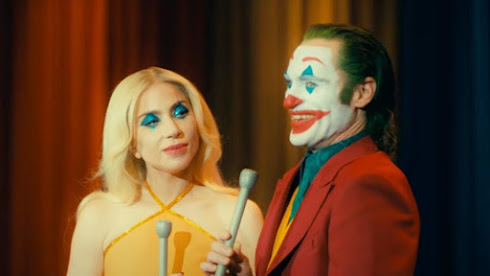 |
| Jeremy Strong and Sebastian Stan |
The Apprentice
Something Wicked This Way Comes
 |
| Jonathan Pryce |
Book Review: Lawrence Tierney: Hollywood's Real-Life Tough Guy by Burt Kearns
 |
| Lawrence Tierney |
Only the Animals
 |
| Nadia Tereszkiewicz |
The Beast
 |
| Léa Seydoux |
Bertrand Bonello's La Bête is made up of three variations of Henry James' novella "The Beast in the Jungle", a formal approach that dovetails nicely with Bonello's former career as a session pianist. The James tale features a male protagonist, John Marcher, who ruins his own life and that of his lady love through a lifelong fear that catastrophe is lurking for him like a beast of prey. The protagonist of Bonello's film, in three iterations, is named Gabrielle and is played by screen icon Léa Seydoux. Her would be suitor is named Louis, who is played by George MacKay (1917, Captain Fantastic) in the three time periods covered by the film. In each strain of the film, the ending is tragic.
The three time frames captured by the film allow for variations in story, production design, and locale, but the theme remains pretty much the same. One part is set in the Belle Époque Paris of 1910. In this section, Gabrielle is a married pianist living a complacent existence hinted at by her husband's business, manufacturing baby dolls. Gabrielle is tempted by English expatriate Louis who is privy to her secret fear. This story line is juxtaposed with one set in Paris in 2044. An unexplained plague has decimated the populace. Those who survive wander the streets with protective masks. AI and robotics dominate the landscape. Gabrielle is undergoing a sinister seeming "purification" treatment recommended by her AI medical pooh-bahs. A very different kind of doll is available for humans, Gabrielle's robot is embodied beautifully by Guslagie Malanda (Saint Omer) . Gabrielle meets Louis at a bar that morphs into different periods. She pines for him, but has difficulty tracking him down.
At La Bête's midpoint, Bonello wraps up the 1910 story and sends this version of Gabrielle and Louis to a watery grave. He introduces a story line set in 2014 Los Angeles. There, Gabrielle is a struggling model/actress who is house sitting for a wealthy client. Louis is a menacing incel type who ends up stalking Gabrielle. One of the few off notes of the film for me was MacKay in the 2014 section. He nails his character's cynicism, but seems overly hale for an incel. Otherwise, he is quite good trading je t'aimes in French to the 1910 Gabrielle or apparating in the future in a Pierre Cardin Beatle suit. Even in a dud like Laurent, Bonello has been masterful in exploiting his costume and production designers, coiffeuse, and sound mixers. The technical aspects of La Bête are all top notch. The floral displays and Ms. Seydoux's hairstyles are sublime. The outfits for her also contribute to the film's mise-en-scene in intriguing ways. When Gabrielle invites Louis to her husband's doll factory for a tryst, her red ensemble incinerates the screen with repressed longing before the muted blue and white set literally explodes in flames due to the Paris flood of 1910.
The only other brickbat I could hurl at the film concerns a scene where a forbidding pigeon attacks Gabrielle. The ability to film action scenes does not fit with the Gallic temperament. Otherwise, this is Bonello's best film thus far and one of the best of the past year. Bonello, not surprisingly, excels in his use of music. Patsy Cline's "You Belong to Me" is used for ironic effect as Gabrielle is stalked and Roy Orbison's "Evergreen" is a beautifully appropriate hymn to eternal love. The film, ultimately, belongs to Seydoux. She is onscreen for nearly all of this 145 minute film and handles the subtle modification of the various Gabrielles like the master technician she is. The actor of her generation? Peut-etre.
The People's Joker
 |
| Vera Drew |
The Best of David Lynch
 |
| 1946 - 2025 |
Juror #2
 |
| Nicholas Hoult |
Les Favoris de la lune
 |
| Fetching a price in Les Favoris de la lune |
About Dry Grasses

I highly recommend Nuri Bilge Ceylan's About Dry Grasses with the usual caveats about the Turkish director's work. The film is over three hours and very talky and deliberately slow. The camera rarely moves and views the characters remotely. The protagonist is unlikeable. Yet, I savored the film like a fine wine. Ceylan 's remote camera fits a story which is largely concerned with distance between individuals, an ongoing theme in his work. Neophyte directors like Zoë Kravitz in Blink Twice tend to overuse close-ups. In that film, when things get horrific, close-ups of terrorized victims don't have the impact they should because the previous surfeit of the effect ameliorates subsequent usage. Because Ceylan is sparing in his dynamic use of the camera, whips pans and close-ups, particularly one of a pistol, convey the emotional impact intended.
The use of long shots also fits the plight of the main character isolated in a remote village in the hinterlands of Eastern Anatolia. There, the protagonist of the film, Samet (Deniz Celiloğlu), teaches middle school. He is bitter about being stuck in such a Podunk burg and does not endear himself to his colleagues by constantly complaining about his plight. Of all his colleagues, Samet is closest to Kenan (Musab Ekici) with whom he shares a house. A comely teacher from a larger town nearby named Nuray (Merve Dizdar) enters into a triangular relationship with them that remains superficially pleasant, but underlying tensions simmer. Ceylan's long shots emphasize the beauty and the harshness of the locale. It is extremely difficult to get around in the Anatolian winter, especially for Samet who does not own an automobile. He is constantly bumming rides and sloshing slowly through the slush.
The film's main two plot threads concern sexual power dynamics. Nuray seems to prefer Kenan to Samet, but Samet is able to manipulate Nuray into a one night stand. Nuray is missing a leg from a terrorist attack in Ankara. She fears her attractiveness has diminished and Samet, though not in love with her, is able to manipulate her to his own ends. Samet and Kenan are also embroiled in a small scandal at school when they are charged with being too friendly with young female students. Certainly, what we see of Samet's relationship with his favorite, Sevim, while not overtly sexual, borders on grooming. On the other hand, Sevim is a bit of a minx who has her own subtle power. When Sevim incurs Samet's wrath, he lords his petty power over her. Still, at film's end, it is difficult to say which of the two has gained the upper hand.This theme of sexual power plays is just one of the motifs in About Dry Grasses that has caused the film to be called Dostoyevskian. In the crazed Russian's fiction, even frustrated virgins and cripples have sexual magnetism and power. The servant often becomes the master when individuals are possessed by eros. Other Dostoyevskian themes here include exile, free will versus determinism, and the plight of animals as a metaphor for eternal suffering. As one character puts it, " How do you expect to care for dogs when no one cares about people." Like Fyodor's Russian, Ceylan's Turkey is a paranoid police state with the icons of power (Atatürk and Erdoğan) watching over. Perhaps the most Dostoyevskian aspect of the film is Samet himself. Samet, much like Ivan Karamazov, is ruled by reason. He sees life's ambiguities rather than its possibilities, hobbled by what Bob Dylan calls "useless and pointless knowledge." He lacks the saving grace of compassion. The only grace notes he strikes are in his photographic portraits, a skill he downplays but which betray traces of empathy and humanity.
Merve Dizdar won most of the critical accolades for her performance as Nuray, and she is very good, but it is a Mother Courage type role of the sort that begs for awards. I was equally impressed by Deniz Celiloğlu who, as Samet, embodies the contradictions of his character. About Dry Grasses is an actor's feast, as Ceylan gives the cast long, digressive conversations usually, but not always, over tea. This is not everybody's ideal of cinema, much as Dostoyevsky is not everybody's ideal of literature (especially Nabokov who thought Fyodor should have written for the theater), but I'll take it over whatever CGI comic book movie you can think of.
Quick Takes, January 2025
 |
| So This is Paris |
Damian Mc Carthy's Oddity has been marketed as a horror film, but I would describe it as a slow burn revenge thriller with supernatural elements. The film represents an incremental advancement rather than a great leap forward for Mr. Mc Carthy after the promising Caveat. This time he has written some actual characters and devised a much more complex plot, but his cast is subpar. I did enjoy the performances of Carolyn Bracken, Tadhg Murphy, and Steve Wall, though.
Molly Manning Walker's How to Have Sex is a coming of age film in which three young British females travel to a cheesy resort in Crete. The usual hijinks ensue in a film not all that dissimilar to Where the Boys Are. Lead Mia McKenna-Bruce, who emanates a star's talent and charisma, provides rueful notes that ground a film teetering on the brink of insubstantiality.
Zoë Kravitz's feature debut as a director, Blink Twice, shows promise. The film is slick, maybe too slick. However, the script ends up regurgitating White Lotus and Knives Out with Channing Tatum starring as Jeffrey Epstein. I did like the supporting cast, especially Alia Shawkat, Christian Slater, Geena Davis, Simon Rex, and Adria Arjona.
Joker: Folie a Deux
 |
| Lady Gaga and Joaquin Phoenix |
Biff's Favorite Pop Music Releases of 2024
Biff's Favorite Books Read in 2024
1) Harlem Shuffle by Colson Whitehead
-
One wholesome, unassuming icon plays another in A Beautiful Day in the Neighborhood Tom Hanks or rather his persona is the embodiment of...
-
Oscar Isaac I was largely knocked out by Guillermo del Toro's Frankenstein even though another go at this old chestnut was the last thin...
-
Léa Seydoux Bertrand Bonello's La Bête is made up of three variations of Henry James' novella "The Beast in the Jungle", a...
-
Vera Drew Vera Drew's The People's Joker is a queer and trans coming of age tale that appropriates the mythology of the Batman uni...
-
1946 - 2025 Sex is a doorway to something so powerful and mystical, but movies depict it in a completely flat wa...
















